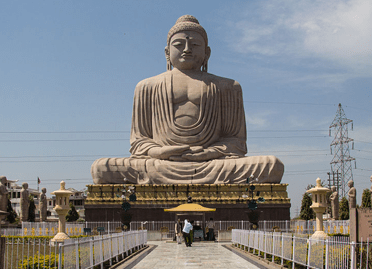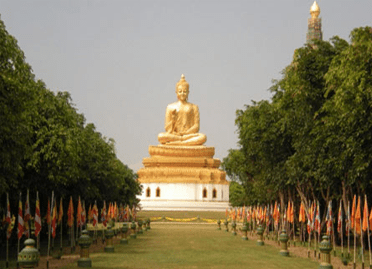Where am I : India Tour Packages » Most Popular Packages » Kapilavastu Tour Packages
View Details

Destinations Covered : Delhi » Bodhgaya » Varanasi » Kushinagar » Lumbini » Kapilavastu » Shravasti » Lucknow
View Details

Destinations Covered : Varanasi » Bodhgaya » Rajgir » Nalanda » Patna » Kushinagar » Lumbini » Kapilavastu » Shravasti » Balrampur » Lucknow
Kapilavastu Tour Pacakges
Lumbini is presently being developed according to the Lumbini Development Trust's Master Plan, which is committed to the preservation and development of Lumbini as a pilgrimage site. The concept, designed by famed Japanese architect Kenzo Tange and finished in 1978, Will turn three square kilometers of land into a holy space with gardens, ponds, structures, and forests. Lumbini Village will comprise lodges, restaurants, a cultural center, and tourism amenities, as well as a Monastic Zone, the circular holy Garden encircling the Ashoka pillar, and Maya Devi temple.
The ancient palace where Lord Buddha spent his formative years, Kapilvastu, is a famous archaeological site near Lumbini.
Trip Notes
This tour requires booking, and rates are subject to change at the time of booking. Children under the age of 12 must be accompanied by their parents. Please budget $10 for lunch, and if wanted, our guide will assist you in choosing a good local eatery.
Services Included
• Private Ac car pick-up and drop-off
• English-speaking guide
• Monument/Temple Admission Fees
• Drinking mineral water while touring
• Includes all taxes, fuel surcharges, and service costs
History of Kapilavastu
What was the name of the Prince of Kapilavastu?
Kapilavastu was an ancient city that served as Shakya's capital. King Uddhodana and Queen My, as well as their son Prince Siddartha Gautama, are said to have resided in Kapilavastu until he departed at the age of 29.
Today, it is found in Nepal.
In Sanskrit, the Shakya denotes "capable" or "able." Kapilavastu is the Shakya capital. Siddhartha Gautama, a prominent Shakya prince, developed Buddhism in the 5th century BCE. The governance of Kapilavastu now follows the Indian Constitution.
The Shakya capital (Kapilavastu) has a long history, and the residents tell various legends about faith and belief. The legends date back centuries.
Where did the name Kapilvastu come from?
Kapilvastu was named after the Vedic sage Kapilamuni, according to Buddhist traditions. Kapilavastsu refers to both the kingdom and the administrative center or capital of the Shakya dynasty, which was controlled by King Suddhodhana in the sixth century BC.
Siddhartha Gautama
- the Buddha, c. 563-483 BCE
- grew up and resided at Kapilavastu for the first 29 years of his life
Place of Kapila
- The sage Kapila is credited with the city's name.
The holy spirit of prince Siddharth
Gautam Buddha spent his youth amid the rich surrounds of Kapilavastu, the capital city of the Sakya, one of the oldest republics. He witnessed sadness and agony, sickness and death here. Finally, he resolved to sacrifice all worldly possessions and pleasures to seek truth and go on the road of redemption after seeing a glowing joyful Sadhu who had mastered all of them. Between 1971 and 1977, the Archaeological Survey of India conducted excavations. Archaeologists discovered an inscription dating from the Kushan period in a stupa called the Eastern Stupa that was excavated. Om devaputra vihare Kapilavastu bhikku sanghasa (This is the Devaputra Vihara of Kapilavastu) was the wording on it. Two excavated mounds are located 1.5 kilometers from the site. The largest one is a thick-walled edifice that was Suddhodana's palace, according to local legend. In the area of the remains lies Mahinda Mahavihara, a tiny Sri Lankan monastery, and shrine.
Why will you love Kapilavastu?
• You'll be enthralled with Kapilavastu and the Buddha Legend. Suddhodana of Kapilvastu and Maya of Devadaha were prince and princess (later king and queen) according to Siddhartha Gautama's history from early Buddhist writings, and Kapilavastu itself is frequently referred to as a kingdom or royal city. They had no children for the first 20 years of their marriage, but one night, Maya had a vivid dream in which four supernatural spirits brought her away to a garden and washed, anointed, clothed her in white, and showered flower garlands upon her. In the dream, a white elephant emerged and circled her three times before entering her womb from the right side. Maya discovered she was pregnant the next morning. As her due date approached, she gathered an entourage and traveled out to her hometown of Devadaha, as was customary. The company came to a halt in Lumbini's gardens, which are located between the two cities and may have been manicured and maintained by both, so she could wash and relax. Maya got out of the water after her bath and went into labor, giving birth to her baby beneath a Sala tree limb she held to for support.
As soon as he was born, the baby is believed to have stood up, taken seven steps, and declared his entrance as a peacemaker. Following that, the group seemed to return to Kapilavastu, where a sage foretold that the young prince would grow up to be a powerful ruler or spiritual leader. Maya died seven days after his birth, and his father, fearful that exposing his son to such suffering – or any kind of suffering – would inspire him to pursue spirituality rather than politics, decreed that he should never experience such pain, and took steps to ensure that he did not, quickly marrying Maya's sister, Prajapati, to provide his son with a mother. Suddhodana's goal, depending on whatever version of the narrative one reads, was to surround young Siddhartha with lavish diversions, keep him constantly occupied in studies and pleasures, surround his palace with a pleasure compound enclosed by a high wall, or all of the above. Siddhartha lived in this utopia for 29 years, married, and had a son before being exposed to life's misery while out on a ride beyond the gates of Kapilavastu by the Four Signs — an elderly man, a sick man, a dead man, and a spiritual ascetic.
The revelation that he had been living in his father's fantasy world and that he, too, would one day suffer from illness, old age, and death rendered his previous existence untenable. Everything he cared about will be lost one day, and everything he considered to be true was a lie. He resigned his post and left Kapilavastu, committing himself to the spiritual ascetic path until he obtained enlightenment and was known as the Buddha ("the awakened one"). Following that, he spent the next 45 years of his life teaching others how to free themselves from illusion and pain so that they might live in peace.
Where is Kapilavastu in India?
The Kapilvastu Region: Located in central Nepal's plains and stretching over the present-day India-Nepal border, the district of Kapilvastu is rich in Buddhist history. The location is roughly six kilometers (3.7 miles) south of the palace at Tilaurakot, where Buddha spent his infancy. Kudan was a gathering place for Buddha's disciples and also the site of the ordination of Buddha's son, Rahula, which was marked by a stupa constructed atop the highest hill. At Kudan, there were also important theological discussions, such as whether women should be ordained. Although Buddha first refused, his stepmother, Mahprajpat Gautam, persuaded him to accept the proposition and became the first bhikkhuni, or Buddhist nun. The Bihar ("house") excavation began in 2007, exposing old stone and masonry.
A well, three stupas, and the ruins of a vast pond are among the auxiliary constructions at the site. The Bihar itself stands 22 feet tall and covers an area of almost 15,000 square feet. A shady stairway leads daring visitors to the top of the Bihar for an unrivaled view of the whole site as well as the location of a well-worn Shiva linga.
Historical Monuments in Kapilavastu
• Kapilvastu Archaeological Site, Nepal
After attaining enlightenment, Sakyamuni Buddha first met his father at this location. AWAY FROM THE MAIN ROAD that leads north from India to Kapilvastu, Nepal, sits a fairly commonplace mound of bricks gracing a mundane field.
It would be simple to pass by this location without further study, but that would be a mistake given the site's historical and religious significance. The location, now known as Kudan after a neighboring town, is thought to be the Nigrodharam Bihar referenced in Buddhist literature as the place where Buddha first met his father, King Suddhodhana, after his enlightenment.
Although many aspects concerning Buddha's life and the early propagation of his doctrine
Learn Before You Go
It is important to hire a skilled guide to get the most out of your visit to Kudan, as interpretative signage is minimal and in some instances illegible.
• Reservoir Jagdishpur
The Jagdishpur Reservoir is a reservoir in Nepal's Kapilvastu District, located near Jahadi Village Development Committee. It is the country's largest reservoir and important wetland habitat, with a surface area of 225 acres. It is located at a height of 197 meters. During the dry season, the greatest water depth is 2 meters, whereas, during the monsoon season, it is 7 meters. The Ramsar List of Wetlands of International Importance, as defined by the Ramsar Convention, includes the Jagdishpur Reservoir.
What are the top fascinations to visit in Kapilavastu?
Tilaurakot
The most well-known destination in the Kapilvastu district. Siddhartha has resided in this house for 29 years. At the age of 29, he fled the palace in search of enlightenment. The Tilaurakota Palace was named a World Heritage Site in 1996.
Tilaurakot Museum
Museum Has a collection of jewelry, ornaments, and coins that date back to the 7th century BC. Some of the objects found during excavation from Tilurakot Palace are also kept in this museum.
Gotihawa
Gotihawa is a VDC 4 kilometres east of Kapilvastu. Krakuchanda Buddha was born there, according to Theravada Buddhism. 900 BC artifacts were discovered during a 1994 excavation in Gotihawa by archaeologists.
Nigrodharam
Nigrodharam, another major Buddhist site, is also known as Kudan. Taulihawa lies 2.5 kilometers south of Nigrodharam. This is where King Suddhodhan Shakya built a large vihara to see his son for the first time after achieving enlightenment. This is also where Buddha gives his talk to his disciples, including his wife and children. Excavation is also taking place, and they are discovering antiques dating back to the eighth century BC.
Araurakot
Kanakamuni Buddha was born at Araurakot, which is located 1.4 kilometers east of Niglihawa and ten kilometers northeast of Taulihawa. Kanakamuni Buddha was born, raised, and married in Araurakot. Here you may observe the historic ruins of a moat and brick defenses.
Niglalihawa
According to Theravada Buddhists, Konagamana Buddha was born in Niglalihawa and is recorded in Buddhavamsa chapter 23. Ashoka visited this spot in 249 B.C. and built a pillar with an inscription that may still be seen today. It is roughly 7 kilometers northeast of Taulihawa on the Indian-Sri Lanka border.
Jagadishpur Lake
In addition to archaeological monuments, the Kapilvastu Municipality of Jagadishpur has a lake. This lake is 11 kilometers northwest of Tailihawa. Jagadishpur Lake is 157 hectares in size and home to a variety of bird species. This lake provides a stopover for migrating birds from China, Russia, Siberia, Mongolia, Turkmenistan, and Kyrgyzstan. This lake is home to around 22,000 birds. The birds begin migrating here in the winter and stay until February. Gadwall, Northern pintail, Ferruginous deck, Northern shoveler, Eurasian Wigeon, Common Pochard, and Cotton Pygmy Goose are all common birds.
Buddhist Circuit Tour
The Buddhist Circuit is a pilgrimage excursion that follows Buddha's footsteps and visits key historical sites. This trip takes us from his birthplace to the places where he meditates and gained enlightenment.
There are around 62 archaeological sites scattered throughout the area. Tilaurakot, Kudan, Gothihawa, Niglihawa, Sagarhawa, Aurorakot, Devadaha, and Ramagrama are all stops on the Buddhist Circuit Tour.
- Puskar pond is said to have been the place where Queen Mayadevi bathed before the birth of Siddhartha Gautam. Siddharthasiddhartha had his first bath at this pond as well when he was born, according to legend.
- Bodhgaya Siddhartha Gautam attained enlightenment under the bodhi tree at Bodhgaya, Bihar, India. He attained enlightenment and became Lord Buddha after a period of constant meditation. The Bodhi Tree, Animeshlochana Chaitya, Ratnachankramana, Ajapala Nigrodha Tree, Rajyatna Tree, and Muchhalinda Pond are some of the most important pilgrimage sites.
- Kudan Kudan lies 4.5 kilometres to the south of Tilaurakot. This is the location where Buddha and King Suddhodhan first met after enlightenment. The Kasaya (yellow robe used by monks) was donated to Lord Buddha at Kudan.
- Sarnath is where he began to offer discourses to his disciples after attaining enlightenment. This location is 13 kilometers northeast of Varanasi. This is where Jesus established his first followers to spread the new doctrine. Asoka built the Dhaka Stupa at Sarnath, which has a remarkable lion capital pillar.
- Sarnath is where he began to offer discourses to his disciples after attaining enlightenment. This location is 13 kilometers northeast of Varanasi. This is where Jesus established his first followers to spread the new doctrine. Asoka built the Dhaka Stupa at Sarnath, which has a remarkable lion capital pillar.
Tip for those who are going on a Kapilavastu tour
Attractions
On this customized trip, which includes stops in Lumbini and Kapilvatsu, learn about what it means to make a Buddhist pilgrimage. With this trip designed specifically for your private group, you'll get individual attention and a tailored schedule. Travel at your leisure as your guide provides commentary on the history and culture of the major monuments, which include the UNESCO-listed Sacred Garden, the Ashoka Pillar, and the Royal Thai Monastery.
Learn about Buddhist pilgrimage places' historical and cultural importance. A private tour is one in which only your group and a guide/driver are present. Private tours imply individual attention and the opportunity to ask questions. Entrance costs are included. Private round-trip transportation and hotel pickup and drop-off are included.
- Every year, between December 29 and December 31, Kapilavastu Buddha Mahotsav is held. These three days are extremely significant in the life of a Buddhist.
- The Stupa Complex was established and designated as an archaeological monument in the early 1970s.
- The palace site was discovered during excavations in the 1970s and is thought to be that of King Shuddhodhan, Lord Buddha's father.
- Gorakhpur is approximately 110 kilometers from Kapilavastu. Imambara and Dargah are two historic Buddhist shrines in this area. When you visit the city, you will believe in the tagline "unity in variety."
- Ayodhya: Lord Ram is said to have been born in this city. The city is situated on the Sarayu River's banks. It is a significant holy site.
How to get it?
By Air
Gorakhpur Airport is the closest domestic airport. Flights from the airport to Delhi are plentiful. Kapilavastu is about 108 kilometers from the airport. From the airport, tourists can take expensive taxis or private automobiles to Kapilavastu.
By ROAD
Tourists may access the site by road from Lumbini, Kushinagar, and Sravasti by boarding State-run private buses or hiring a cab. In comparison to Kushinagar and Sravasti, Kapilavastu is only a few minutes drive from Lumbini.
By Train
Kapilavastu is about 21 kilometers distant from the nearest railway station. The train station is well serviced by buses and taxis.
Rental cars services in Kapilavastu
The intended usage and the number of passengers.
When renting a car, consider the objective of the rental. For example, if you're going sightseeing in Kapilvastu with a few friends, you should hire an eco-car to save money on gas. However, if you need a car to go up the hill, you'll need an SUV, and if you need to travel great distances and carry a lot of luggage, you'll need a van or pickup truck. The majority of rental automobiles offer a no-cost cancellation policy. So hiring a car ahead of time is not an issue, and you will not be charged a booking fee.
Compare vehicle rental pricing in Kapilvastu, car types, and distances that may be driven for free. Conditions such as whether or not free insurance is available. Following the "Search" button, the system will provide a list of rental cars with options to choose the car rental business, car type, and the number of passengers each car can carry. To choose the finest rental car at the greatest price for your trip.
Kapilavastu Important instructions when you rent your car
Importance
Car rentals relieve you of the burden of maintenance costs and depreciation losses. If you don't need a car every day and simply use it on rare occasions, renting one is the ideal option because it saves you money on insurance, service, and MOTS.
How do I ensure to rent a car?
"The single most critical strategy to guarantee that a) you have a rental at all, and b) you don't end up spending more than you have to for it," he added. Check rental costs before making a reservation to ensure that it is both available and cheap.
Speak to our Experts!
Instant Quote, Best Deals - 100% Customizable, Includes hotels + car + guides Cost depends on various factors like, number of people you are, travel dates, category of hotel and transportation etc.Drop your Inquiry to get the best deals as per your requirements. 100% Satisfaction Guaranteed. Rated 5* in TripAdvisor.Loading...




